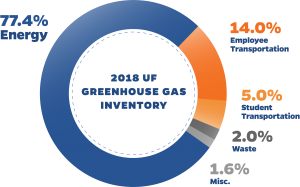Buildings
The UF campus contains 900+ buildings, including the first LEED Platinum-certified building in the state of Florida. UF staff and building professionals work together to ensure that the campus infrastructure meets green goals.
The University of Florida is in the process of updating the UF Climate Action Plan (UF CAP 2.0). This process is focused on developing a shared strategic framework for reducing and mitigating UF’s Greenhouse Gas Emissions (GHG) including those associated with building energy use.
Since 2016, UF has engaged in a robust campus planning program. Several plans have been developed – starting with a high-level vision for campus and community, then continuing through plans for campus systems and the Campus Master Plan. These plans inform sustainability policies and practices when it comes to creating and renovating buildings at UF.
Energy use is the primary contributor to UF’s overall greenhouse gas emissions. UF is working hard to reduce energy use by constructing more efficient buildings, managing building temperatures with special programs, retrofitting lighting systems, and implementing renovations to heating, ventilation, and air condition systems across campus.
A Greenhouse Gas (GHG) Inventory is a comprehensive look at the major sources of GHG-related emissions created through an institution’s regular operations. Since the first endeavor to compile UF’s GHG Inventory in 2004, UF has worked to improve the tracking, reporting and calculations to create a more accurate picture of the university’s emissions.

UF prides itself on having more green building certifications than any other public higher education institution in the country! Through renovations and new construction alike, UF projects follow green building principles to provide healthy indoor environments while also reducing the use of Earth’s resources.
